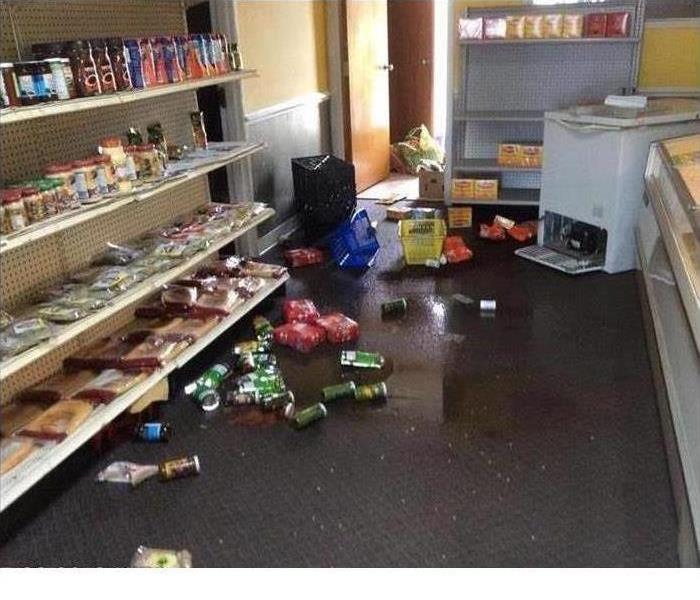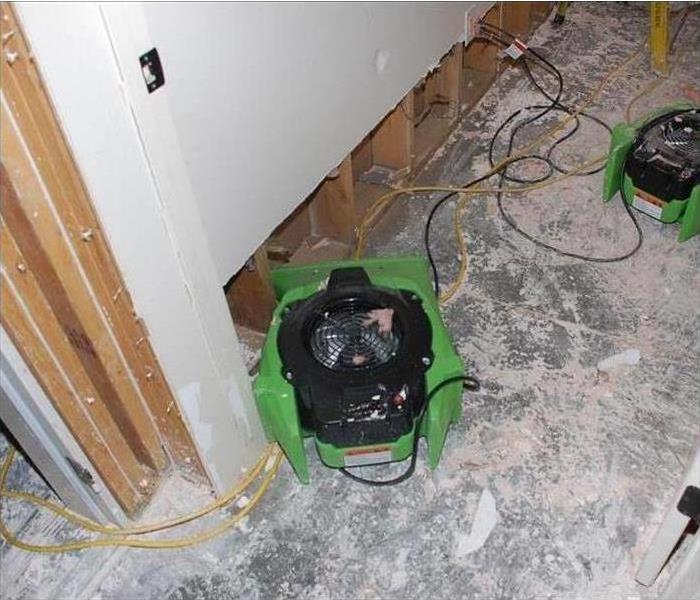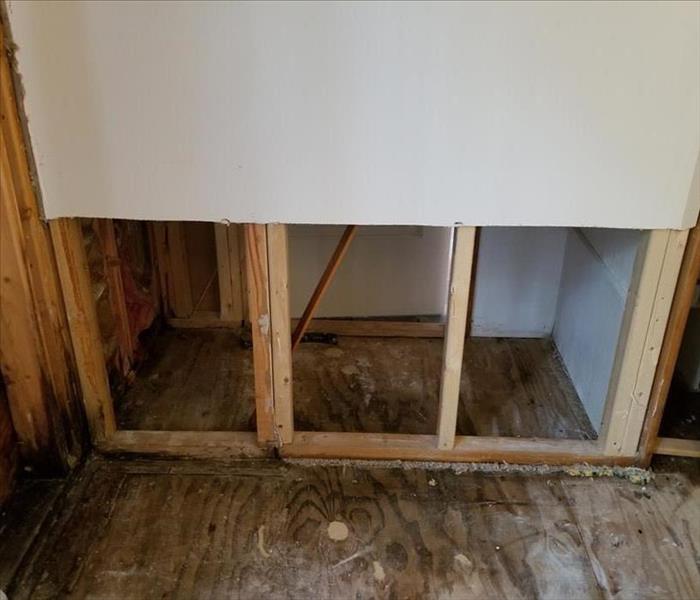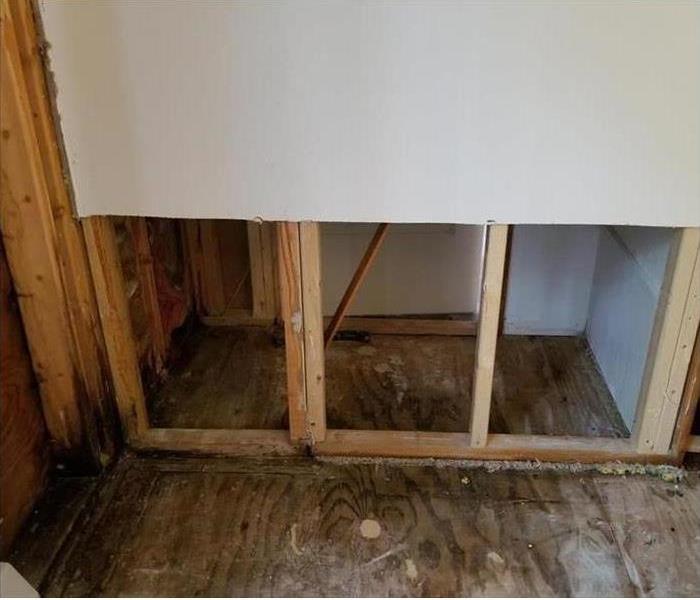Recent Storm Damage Posts
How to Craft a Family Disaster Plan: Steps for Preparedness
5/3/2024 (Permalink)
 By taking proactive steps to create a family disaster plan, you can enhance the safety, resilience, and preparedness of your household.
By taking proactive steps to create a family disaster plan, you can enhance the safety, resilience, and preparedness of your household.
In times of crisis, having a well-thought-out family disaster plan can make all the difference in ensuring the safety and well-being of your loved ones. From natural disasters like hurricanes and wildfires to emergencies such as house fires and power outages, being prepared and having a clear plan of action can help mitigate risks and minimize the impact of unforeseen events. Here's a step-by-step guide to creating a comprehensive family disaster plan:
Identify Potential Risks
Begin by assessing the types of disasters that are most likely to affect your area. Consider natural hazards such as earthquakes, floods, tornadoes, and severe storms, as well as human-made emergencies like chemical spills or industrial accidents. Understanding the specific risks in your region will inform the development of your family disaster plan.
Establish Communication Channels
Designate a central communication point where family members can gather information and coordinate during emergencies. Ensure that everyone has access to important contact numbers, including local emergency services, relatives, neighbors, and schools or workplaces. Consider using multiple communication methods, such as text messages, phone calls, and social media, to stay connected.
Create Evacuation Routes
Identify primary and secondary evacuation routes from your home and establish meeting points where family members can reunite if separated during an emergency. Map out evacuation routes on a physical or digital map, highlighting key landmarks, shelters, and safe zones along the way. Practice evacuating your home regularly to familiarize everyone with the routes and procedures.
Stock Emergency Supplies
Assemble a comprehensive emergency kit containing essential supplies to sustain your family for at least 72 hours following a disaster. Include items such as non-perishable food, water, first aid supplies, medications, flashlights, batteries, blankets, and personal hygiene products. Customize your emergency kit to meet the specific needs of your family members, including infants, elderly individuals, and pets.
Assign Responsibilities
Assign specific roles and responsibilities to each family member based on their skills, abilities, and age-appropriate tasks. Designate someone to initiate the family disaster plan, oversee communication efforts, gather emergency supplies, and assist vulnerable individuals such as children, elderly relatives, or pets. Encourage open dialogue and collaboration to ensure everyone understands their role in executing the plan.
Practice, Review, and Update
Regularly review and update your family disaster plan to reflect changes in circumstances, such as new family members, home renovations, or updates to emergency contact information. Conduct practice drills and tabletop exercises with your family to reinforce emergency procedures and improve response times. Use these opportunities to identify any gaps or areas for improvement in your plan.
By taking proactive steps to create a family disaster plan, you can enhance the safety, resilience, and preparedness of your household in the face of emergencies. Remember, preparation is key to effectively responding to disasters and safeguarding the well-being of your loved ones.
How to Protect Your Roof from Heavy Rain and Wind
9/12/2023 (Permalink)
Living in the Northwest region means encountering its fair share of heavy rain and strong winds. These weather conditions can pose significant risks to your home, especially your roof. To ensure the safety and longevity of your roof, it's essential to take proactive measures to protect it from the elements. In this blog post, we will explore some effective ways to safeguard your roof from heavy rain and wind in the Northwest.
Regular Roof Inspections
Initiating regular roof inspections is crucial in identifying any existing vulnerabilities or potential issues. Engage a professional roofing contractor to inspect your roof at least once a year. They can check for loose or missing shingles, damaged flashing, or compromised areas that could lead to leaks or wind damage. Early detection of problems allows for timely repairs or preventive measures, preventing further damage during heavy rain or windstorms.
Properly functioning gutters and downspouts play a vital role in directing rainwater away from your roof and foundation. Regularly clean your gutters and remove any debris, such as leaves or twigs, that may obstruct the flow of water. Ensure that the downspouts are clear and extend at least five feet away from your home to prevent water from pooling near the foundation. This helps prevent water damage and reduces the risks of leaks or roof deterioration.
Reinforce Flashing and Sealants
Flashing, which consists of metal strips installed around roof edges and penetrations, helps prevent water from seeping into vulnerable areas. Strong winds and heavy rain can dislodge or damage flashing, compromising its effectiveness. Check the condition of the flashing and sealants around chimneys, vents, skylights, and any other areas where the roof meets protrusions. Replace worn-out flashing and apply appropriate sealants to safeguard against water intrusion.
Trim Overhanging Branches
In the Northwest, trees are abundant and can provide aesthetic appeal and shade. However, overhanging branches can pose a risk to your roof during heavy rain and wind. Trim any branches that are close to or hanging over your roof. Falling branches can cause significant damage, puncturing or dislodging shingles and potentially leading to leaks. Regular tree maintenance will help reduce the risk of damage during storms.
Strengthen Roof Materials
When replacing or installing a new roof, consider using durable, wind-resistant materials that are suitable for the Northwest's weather conditions. Opt for roofing materials that have a high wind rating, such as asphalt shingles with a higher wind resistance rating or metal roofing. These materials are designed to withstand strong winds and heavy rain, providing an extra layer of protection for your home.
Ensuring that your roof's structure is strong and well-maintained is essential for withstanding heavy rain and wind. Collaborate with a professional contractor to assess the structural integrity of your roof. They will evaluate the roof trusses, rafters, and other supporting components to identify any weaknesses. Reinforcing weak areas can help prevent roof collapse or significant damage during severe storms.
Protecting your roof from heavy rain and wind in the Northwest requires proactive measures and regular maintenance. Regular inspections, maintaining gutters and downspouts, reinforcing flashing and sealants, trimming overhanging branches, using wind-resistant materials, and strengthening the roof structure are all essential steps to safeguard your roof. By taking these precautions, you can enhance the durability and longevity of your roof and minimize the risks associated with heavy rain and windstorms.
Storm-Proofing Your Business: Essential Steps to Prepare Your Company for Severe Weather
8/10/2023 (Permalink)
As a business owner or manager, it's vital to proactively prepare your company for the potential impact of storms and severe weather. By implementing effective strategies and safety measures, you can minimize disruptions, protect your employees and assets, and ensure a smoother recovery process. In this blog post, we will guide you through essential steps to prepare your company for a storm, enabling you to safeguard your business and maintain continuity during challenging times.
Stay Informed and Develop an Emergency Plan
- Monitor Weather Updates: Stay tuned to reliable weather sources to receive timely information about approaching storms and severe weather conditions.
- Establish an Emergency Response Team: Designate a team responsible for overseeing emergency preparedness efforts, including communication, evacuation procedures, and resource allocation.
- Develop an Emergency Plan: Create a comprehensive plan outlining procedures for employee safety, facility protection, and business continuity. Ensure clear communication channels and designated roles for employees during emergencies.
Assess and Secure Your Physical Environment
- Conduct a Risk Assessment: Identify potential vulnerabilities in your premises, such as weak structures, windows, or roofs, and take necessary steps to reinforce them.
- Clear Surrounding Areas: Remove or secure loose objects, equipment, or debris that could become hazardous in high winds. Trim trees and branches near your building to prevent damage from falling limbs.
- Protect Sensitive Equipment: Safeguard critical equipment and electronics by placing them in secure, elevated areas or investing in protective coverings.
Back Up Data and Establish Remote Access
- Regularly Backup Data: Implement a robust data backup system to ensure critical files and information are protected. Store backups in secure off-site locations or use cloud-based services.
- Enable Remote Access: Equip employees with the necessary tools and technology to work remotely if the office becomes inaccessible. Establish secure remote access protocols for business operations to continue during and after the storm.
Establish Communication Protocols
Start by developing an Employee Communication Plan. Establish reliable channels to communicate with employees during a storm, including text messages, email, phone calls, or a designated emergency hotline. Maintain Contact Information. Keep an updated list of employee contact details and emergency contact numbers.
Communicate with Clients and Customers. Inform your clients, customers, and suppliers about your company's storm preparedness plan and any potential disruptions to services.
Review Insurance Coverage
- Consult with an Insurance Professional: Assess your business insurance coverage and ensure it adequately protects against storm-related risks and damages.
- Document and Inventory Assets: Keep a detailed inventory of your company's assets, including equipment, furniture, and supplies, with supporting documentation such as photographs and receipts. This will facilitate the claims process in case of storm-related damages.
Preparing your company for a storm requires proactive planning, effective communication, and securing your physical environment. By staying informed, developing an emergency plan, securing your premises, backing up data, establishing communication protocols, and reviewing insurance coverage, you can mitigate risks and ensure the resilience of your business.
Avoid Lingering Odors from Flooding
8/26/2022 (Permalink)
 Flood damage in Louisville, CO.
Flood damage in Louisville, CO.
When a business in Louisville, CO, experiences water issues, the problem isn’t just the wetness. Even after the issue seems to have been resolved, lingering odors mean there is likely mold growth happening. If the cause was flood water, there are likely other contaminants that could be left behind if not properly cleaned. Whether it’s a little or a lot of water, a water and mold remediation expert can ensure your property is thoroughly dried, cleaned and sanitized.
Residual Effects of Water Damage
A severe storm, pipe burst, sewage loss or roof leak are just a few potential causes of water damage. No matter what the source is, getting it repaired as quickly as possible is essential to preventing further problems. If the damage continues to spread, it can easily turn into more than just a moisture problem. Along with having to throw away damaged belongings, structural and long-term problems can begin to form.
- Mold growth can begin to happen with 48 hours. If the situation isn’t revolved, mold spores will begin to spread to unaffected areas.
- Drywall and ceilings can begin to sag and lose integrity.
- Electrical components can begin to corrode, creating potential safety hazards.
- Saturated insulation can increase mold growth, as well as loses its ability to resist heat.
- Wood floors can easily become warped, as well as be breeding grounds for mold.
Advanced Tools Eradicate Lingering Effects
In most of the above, mold is a key issue. Instead of hoping for the best or replacing items, which can get expensive, a restoration company can restore many things that are considered unsalvageable, repair affected areas, eradicate mold and deodorize to ensure those lingering effects aren’t able to linger. Depending on the type of damage, there are various cleaning methods to eliminate mold growth and odors, all of which use the latest technology to get your business back to new.
While dealing with water damage may seem like a hassle, leaving it unchecked will make it a much bigger problem. Getting the right help can help make it “Like it never even happened.”
4 Important Things To Know About Commercial Storm Insurance Coverage
7/25/2022 (Permalink)
 Storm damage in a Gunbarrel, CO store
Storm damage in a Gunbarrel, CO store
Four Things To Understand About Your Storm Policy
What should commercial owners in Gunbarrel, CO, expect when filing a claim for storm insurance? This documentation is a safeguard when significant trouble occurs, and owners require financial assistance to fix the premises and tend to work again.
1. Coverage Kicks in After You Pay the Deductible
Before an agent authorizes insurance coverage payment, proprietors must pay a deductible. This fee is listed in your policy. Sometimes, it even varies depending on what caused the concern. A hurricane may have a different price from hail or thunderstorms. Check to determine your upfront costs.
2. Water Damage Payments Depend on the Moisture's Source
Storm insurance isn't flooded insurance. A policy may exclude water intrusion from bodies of water. If saturation happens from a collapsed roof, broken window or busted pipeline, you may receive funds. A thorough investigation of the fluid's origin is necessary to receive this financial aid.
3. Property Loss Compensation Is Usually Part of the Plan
If a roof collapses or water invades the space, inventory, furniture and documents are possibly harmed. Insurance coverage includes a property loss clause, offering financial reparation for these items.
Some things like electronics may be salvageable but require specialized content cleaning services. Funds are available for this treatment.
4. Remediation and Restoration Are Allowed
Before crews put a place back together, a water and mold restoration company should assess for fungal or bacterial hazards. This step is essential to avoid future complications; thus, it's important to both the agent and commercial owner. Coverage usually allows for it. Using this evaluation, a team should focus on remediating current damage before rebuilding.
Protect your assets and property with a storm insurance policy. Weather systems are unpredictable, and they could leave commercial owners facing mountains of bills to get back to work. Coverage could be a financial lifeline to reopening.
The 4 Stages of Storm Damage Restoration
6/20/2022 (Permalink)
 If bad weather damages homes in Boulder, CO, homeowners must act quickly.
If bad weather damages homes in Boulder, CO, homeowners must act quickly.
Storm Damage Restoration in Four Stages
Homeowners must act quickly if adverse weather damages residences in Boulder, CO. The restoration process may take several days, depending on the extent of damage and whether it is necessary to tear out and replace building materials or contents. Trained professionals can swiftly proceed through the four stages of storm damage restoration.
1. Mitigation
It is imperative to limit storm damage. Mitigation may involve tarping over a damaged roof, boarding up broken windows, or other measures to prevent further damage.
2. Water Extraction
Water that is left standing for days will become increasingly contaminated and heighten the risk of mold. If a storm introduces Category Two gray water into a structure, this water can degrade into grossly contaminated Category Three black water within a matter of hours.
Homeowners may rent a pump to remove water or start the process by using a mop or wet vac. Damage mitigation professionals will be able to extract every trace of water and debris more quickly, which can limit water damage and help to prevent secondary damage.
3. Cleanup
It is important to remove debris as well as any damaged materials. It may be necessary to tear out porous building materials or contents saturated with contaminated water, as these materials may be difficult or impossible to clean completely. Every surface and item should be cleaned and disinfected to discourage mold growth.
4. Restoration
The affected area must be dry before restoration begins. The final stage of the process will involve rebuilding damaged portions of a structure and replacing discarded items.
It may take up to a week or longer to restore storm damage. An organized effort to extract water, tear out damage, clean and allow the affected area to dry may continue for several days. A homeowner in can limit the severity of storm damage by immediately contacting storm restoration specialists in Boulder, CO.
Why Flood Cuts Are Made During Restoration
5/1/2022 (Permalink)
 A flood cut is a way to tear out damaged materials, provide access behind walls for repairs and increase airflow.
A flood cut is a way to tear out damaged materials, provide access behind walls for repairs and increase airflow.
Why Are Flood Cuts Made During Restoration?
Flood cuts serve several important functions inside a commercial structure that has recently been flooded. Restoration professionals may recommend cutting into drywall 12 to 18 inches above the flood line to identify and remove contaminated building materials and promote drying prior to restoration. Find out more about why storm damage cleanup experts may make cuts after flooding at a building in Louisville, CO.
Remove Contaminated Materials
Flood cuts make it easier for restoration professionals to check the condition of several materials in walls. The following substances may need to be torn out and replaced:
- Drywall
- Insulation
- Structural components
A flood cut is a way to tear out damaged materials, provide access behind walls for repairs and increase airflow. This measure is most important when damage that involves contaminated water has occurred.
Speed Up Drying Behind Walls
Flood cuts open up the walls of commercial buildings that have recently been exposed to flooding. If water has saturated drywall or worked its way behind walls in other ways, it can be difficult to promote fast drying without making significant cuts. If the water involved in damage is not contaminated, it may be possible to save walls by drilling small holes behind the baseboard and inserting hoses to circulate air behind walls.
Clear the Way for Rebuilding
Removing damaged drywall and wet insulation lays the groundwork for rebuilding. Once a structure has been cleaned and disinfected to get rid of sources of contamination and then dried thoroughly, the restoration process is ready to proceed.
Commercial building owners and managers who are not sure whether to make flood cuts should seek the expert opinion of damage restoration professionals who specialize in flooding. These specialists can determine the right height for a flood cut to check conditions behind walls, tear out contaminated building materials and speed up drying at a commercial property located in Louisville, CO
3 Ways To Avoid Mold After a Flood
4/1/2022 (Permalink)
 Some building materials are more prone to mold growth. Molds feed on cellulose plant fiber, which is found in drywall.
Some building materials are more prone to mold growth. Molds feed on cellulose plant fiber, which is found in drywall.
3 Tips For Avoiding Mold After A Flood
Flooding can severely damage structures in Lafayette, CO, and mold may continue to cause problems even after an immediate response to water damage. It is important to take these three timely measures to mitigate water damage and manage risk factors for mold growth.
1. Extract Standing Water
One of the most decisive factors for a mold infestation is the presence of standing water or residual moisture in the days after a structure floods. Extracting water with pumps, a mop or a wet vac is the first step toward preventing surfaces from staying saturated long enough for mold to start multiplying, which can occur in as little as two to three days.
2. Tear Out Ruined Building Materials
Some building materials are more prone to support mold growth than others. Drywall and carpet both contain the plant fiber cellulose, which serves as a food source for mold. When moisture remains present for 48 hours or longer, mold may start to form on or in these materials. Most storm damage restoration experts recommend tearing out and replacing porous materials.
3. Disinfect and Dry the Affected Area
Once any materials exposed to flooding that cannot be thoroughly disinfected have been torn out, all remaining surfaces and contents should be disinfected. Drying the area as quickly as possible makes an environment less conducive for microbes such as bacteria and mold. Air movers and fans can increase circulation, and a dehumidifier can maintain relative humidity levels between 30% and 50% to discourage fungus growth.
Extracting water as soon as possible after a flood and proceeding to remove ruined materials, clean and disinfect the portion of a structure exposed to water damage and maintain low indoor humidity levels reduces the risk of mold growth. Restoration professionals can recommend further measures to ensure that mold does not pose a problem at a commercial property in Lafayette, CO.
What, Exactly, Is a Flood Cut?
3/17/2022 (Permalink)
 When disaster strikes, call SERVPRO. Our staff is available 24/7, 365 and can help with all types of flood damage restoration. Call us.
When disaster strikes, call SERVPRO. Our staff is available 24/7, 365 and can help with all types of flood damage restoration. Call us.
What Is A Flood Cut, And What Does It Mean?
If you want to give your business the best possible care in the aftermath of a flood, you need to know exactly what your flood restoration company has in store for your building. One of the most common procedures performed after severe flooding is a flood cut, a service performed by professional restoration companies in Niwot, CO, to mitigate damage and restore materials that have already been damaged by the flood waters. There are a few noteworthy things to know about this process:
- It’s done to preserve your business’s remaining drywall.
- It cuts off an additional length of drywall to prevent contamination.
- It’s not always necessary; that depends on the type of flood water.
The Cutting Line
While this process is done to preserve the majority of your drywall, it’s typically not just the damaged materials that are removed during a flood cut. Instead, the restoration crew will begin cutting between 12 and 18 inches above where the water damage ends. This is done so that moisture issues behind the wall can be addressed as well, reducing the likelihood for mold growth and other problems in the future.
Preventing Contamination
Typically, you only need to worry about a tear out if your flood water is ranked as water category 3. During this type of flooding, the water can be contaminated with bacteria, sewage or other harmful wastes. When dealing with this type of water, it’s always best to perform a flood cut to completely remove the affected walls in order to reduce the likelihood of contamination to the rest of your building.
Dealing with flooding in Niwot, CO, is never fun or convenient. However, by knowing what your building is in for, you can better prepare your business and your employees for emergency situations and restoration work in the years to come.
 By taking proactive steps to create a family disaster plan, you can enhance the safety, resilience, and preparedness of your household.
By taking proactive steps to create a family disaster plan, you can enhance the safety, resilience, and preparedness of your household.






 24/7 Emergency Service
24/7 Emergency Service




